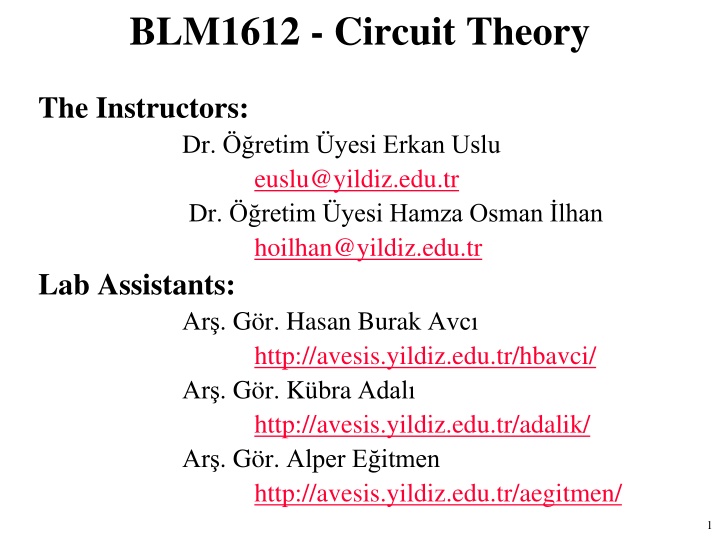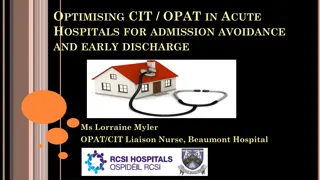
Understanding Operational Amplifiers in Circuit Theory
Learn about operational amplifiers (Op-Amps) in circuit theory, including their behavior, applications, and ideal vs. real models. Explore the significance of Op-Amps in various electronic systems and their common uses in amplifiers, instrumentation, and more.
Download Presentation

Please find below an Image/Link to download the presentation.
The content on the website is provided AS IS for your information and personal use only. It may not be sold, licensed, or shared on other websites without obtaining consent from the author. If you encounter any issues during the download, it is possible that the publisher has removed the file from their server.
You are allowed to download the files provided on this website for personal or commercial use, subject to the condition that they are used lawfully. All files are the property of their respective owners.
The content on the website is provided AS IS for your information and personal use only. It may not be sold, licensed, or shared on other websites without obtaining consent from the author.
E N D
Presentation Transcript
BLM1612 - Circuit Theory The Instructors: Dr. retim yesi Erkan Uslu euslu@yildiz.edu.tr Dr. retim yesi Hamza Osman lhan hoilhan@yildiz.edu.tr Lab Assistants: Ar . G r. Hasan Burak Avc http://avesis.yildiz.edu.tr/hbavci/ Ar . G r. K bra Adal http://avesis.yildiz.edu.tr/adalik/ Ar . G r. Alper E itmen http://avesis.yildiz.edu.tr/aegitmen/ 1
Operational Amplifiers (Op-Amps) 2
Objectives of Lecture Describe how an ideal operational amplifier (op-amp) behaves. Define voltage gain, current gain, transresistance gain, and transconductance gain. Explain the operation of an ideal op amp in a voltage comparator and inverting amplifier circuit. Show the effect of using a real op-amp. Apply the almost ideal op-amp model in the following circuits: Inverting Amplifier Noninverting Amplifier Voltage Follower Summing Amplifier Difference Amplifier Cascaded Amplifiers 3
The Operational Amplifier An operational amplifier (Op-Amp) is a DC- coupled high-gain electronic voltage amplifier with a differential input and, usually, a single- ended output. An Op-Amp produces an output potential (relative to circuit ground) that is typically hundreds of thousands of times larger than the potential difference between its input terminals. The operational amplifier finds daily usage in a large variety of electronic applications. 4
Op Amps Applications Audio amplifiers Speakers and microphone circuits in cell phones, computers, mpg players, boom boxes, etc. Instrumentation amplifiers Biomedical systems including heart monitors and oxygen sensors. Power amplifiers Analog computers Combination of integrators, differentiators, summing amplifiers, and multipliers 5
Symbols for Ideal and Real Op Amps OpAmp uA741 LM111 LM324 6
Terminals on an Op Amp Positive power supply (Positive rail) Non-inverting Input terminal Output terminal Inverting input terminal Negative power supply (Negative rail) 7
Op Amp Equivalent Circuit vd= v2 v1 A is the open-loop voltage gain v2 v1 Voltage controlled voltage source 8
The Operational Amplifier Ideal Op-Amp Rules No current ever flows into either input terminal. There is no voltage difference between the two input terminals. 9
Typical Op-Amp Parameters Parameter Variable Typical Ranges 105to 108 Ideal Values Open-Loop Voltage Gain A 105to 1013 Input Resistance Ri 10 to 100 0 Output Resistance Ro Vcc/V+ -Vcc/V- Supply Voltage 5 to 30 V -30V to 0V N/A N/A 10
How to Find These Values Component Datasheets Many manufacturers have made these freely available on the internet Example: LM741, LM 324, etc. 11
dB Decibels Since P = V2/R 10 log (P/Pref) or 20 log (V/Vref) In this case: 20 log (Vo/Vin) = 20 log (A) = 100 A = 105= 100,000 14
Large Signal Voltage Gain = A Typical A = 100 V/mV = 100V/0.001V = 100,000 Minimum A = 25 V/mV = 25 V/0.001V = 25,000 16
Caution A is Frequency Dependent http://www.national.com/ds/LM/LM124.pdf 17
Modifying Gain in Pspice OpAmp Place part in a circuit Double click on component Enter a new value for the part attribute called GAIN 18
Open Circuit Output Voltage Open Circuit Output Voltage vo= A vd Ideal Op-Amp vo= (vd) Saturation in real Op-Amp An op-amp requires power supplies. Usually, equal and opposite voltages are connect to the V+ and V- terminals. Typical values are 5 to 24 volts. The power supply ground must be the same as the signal ground. Above, +18V is connected to V+and -18 V is connected to V- 20
Open Circuit Output Voltage Real Op Amp Voltage Range Output Voltage Positive Saturation Linear Region Negative Saturation Avd> V+ V-< Avd< V+ Avd< V- vo~ V+ vo= A vd vo~ V- The voltage produced by the dependent voltage source inside the op amp is limited by the voltage applied to the positive and negative rails. 21
Voltage Transfer Characteristic Range where we operate the op amp as an amplifier. vd 22
Ideal Op-Amp Because Ri is equal to , the voltage across Ri is 0V. v1= v2 i2= 0 v2 vd= 0 V i1= 0 v1 23
Almost Ideal Op Amp Ri = Therefore, i1= i2= 0A Ro = 0 Usually, vd= 0V so v1= v2 The op-amp forces the voltage at the inverting input terminal to be equal to the voltage at the noninverting input terminal if there is some component connecting the output terminal to the inverting input terminal. Rarely is the op-amp limited to V-< vo< V+. The output voltage is allowed to be as positive or as negative as needed to force vd= 0V. 24
Example 01: Voltage Comparator is= 0 i1= 0 i2= 0 Note that the inverting input and non-inverting input terminals have rotated in this schematic. 25
Example 01 The internal circuitry in the op-amp tries to force the voltage at the inverting input to be equal to the non-inverting input. As we will see shortly, a number of op-amp circuits have a resistor between the output terminal and the inverting input terminals to allow the output voltage to influence the value of the voltage at the inverting input terminal. 26
Example 01: Voltage Comparator is= 0 i1= 0 i2= 0 When Vs is equal to 0V, Vo = 0V. When Vs is smaller than 0V, Vo = V+. When Vs is larger than 0V, Vo = V-. 27
Electronic Response Given how an op-amp functions, what do you expect Vo to be if v2= 5V when: 1. Vs = 0V? 2. Vs = 5V? 3. Vs = 6V? 28
Example 02: Closed Loop Gain if i1= 0 is v1 v2 i2= 0 29
Example 02 if if is is i1 io i2 For an almost ideal op amp, Ri = W and Ro = 0 . The output voltage will never reach V+or V-. 30
Example 02 if if Virtual ground is is i1 i i2 The op amp outputs a voltage Vo such that V1 = V2 31
Example 02 is i1 if i i2 32
Example 02: Closed Loop Gain = B 0 v V A 1 = V R i C 1 R = S s = v i o f f = i i i s f = / / v V = R R 1 o s f / A R R 1 V f This circuit is known as an inverting amplifier. 33
Types of Gain if if is is i1 io i i2 34
Types of Closed Loop Gain Gain Variable Name AV AI AR AG Equation Units Voltage Gain Current Gain Transresistance Gain Transconductance Gain vo/vs io/is vo/is io/vs None or V/V None orA/A V/A or A/V or 35
Example 03: Closed Loop Gain with Real Op-Amp if if is is i1 v1 i v2 i2 36
Example 03 is= i1+ if i = if - i1= i2 vd= v2 v1= Ri (- i1) = Ri (i2) Vo = Avd- Ro(- i) Vs = R1(is) vd Vs = R1(is) + Rf(if) + Vo Vo /Vs= (-Rf/R1){Ab/[1 +Ab]}, where b = R1/(R1+Rf) 37
Summary The output of an ideal op-amp is a voltage from a dependent voltage source that attempts to force the voltage at the inverting input terminal to equal the voltage at the non-inverting input terminal. Almost ideal op-amp: Output voltage limited to the range between V+ and V-. Ideal op amp is assumed to have Ri = and Ro = 0 Almost ideal op-amp: vd= 0 V and the current flowing into the output terminal of the op-amp is as much as required to force v1= v2when V+< vo< V-. Operation of an op-amp was used in the analysis of voltage comparator and inverting amplifier circuits. Effect of Ri < and Ro > 0 was shown. 38
Almost Ideal Op-Amp Model Ri = and Ro = 0 Linear Region: When V+< vo< V-, vois determined from the closed loop gain Avtimes v2as v1= v2(vd= 0 V). Saturation: When Avv2 V+, vo= V+. When Avv2 V-, vo= V-. 40
Example 04: Inverting Amplifier if i1= 0 is i V+ = 15V V- = - 10V i2= 0 41
Example 04 if i1= 0 is i i2= 0 V+ = 15V V- = -10V 42
Example 04 Closed loop gains are dependent on the values of R1 and Rf. Therefore, you have to calculate the closed loop gain for each new problem. 43
Example 04 = + + = i i i i i 1 2 s f f = / i V R 1 R s S V if = / i f o f = = A V V R R 1 v o s f i1= 0 is = 10 R k f i = 1 R k 1 i2= 0 = 10 A v vo 44
Example 04 Since AV= -10 If Vs = 0V, V0 = -10(0V) = 0V If Vs = 0.5V, Vo = -10(0.5V) = -5V If Vs = 1V, Vo = -10(1V) = -10V If Vs = 1.1V, Vo = -10(1.1V) < V-, Vo = -10V If Vs = -1.2V, V0 = -10(-1.2V) = +12V If Vs = -1.51V, Vo = -10(-1.51V) > V+, Vo = +15V 45
Example 04 Voltage transfer characteristic Slope of the voltage transfer characteristic in the linear region is equal to AV. 46
Example 05 48
Example 05 = = V V V 2 1 S 49
Example 05 = i V R 1 s S ( V ) i = i V V R f S o f = V R o S f f 50










